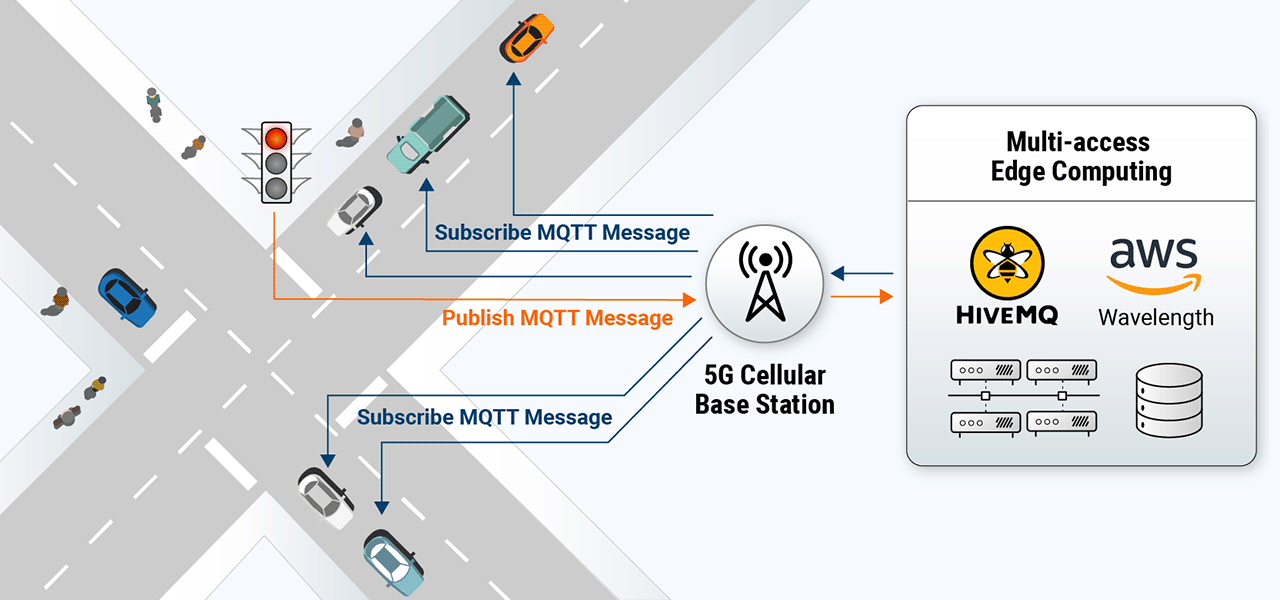
Accelerating Vehicle-2-Everything (V2X) Services with a Modern Data Foundation

Last updated: February 2023
Introduction to V2Xs
Vehicle-2-Everything (V2X) connectivity is about connecting vehicles (V2V), people (V2P), and infrastructure (V2I) for new services like traffic light optimization to improve traffic flow, real-time road condition updates, or even data-sharing among cars in close proximity to cut down on traffic accidents. V2X services have the potential to take connected cars to the next level, making the road a safer place for drivers if V2X is implemented on a large, interoperable scale.
V2X is an extension of the Internet of Things (IoT) on the road, and so the same principles and challenges of connecting things apply. With the onset of 5G cellular networks, the infrastructure to enable V2X is rolling out in major cities around the world. Carriers such as AT&T, Telekom, Verizon and Vodafone have 5G networks available today. The infrastructure for the future of V2X has been laid. The next steps are to enable the use cases and the applications.
A key challenge for enabling V2X applications is to transfer large amounts of data between the vehicles and the infrastructure. 5G networks provide the network bandwidth to meet the low latency requirements. However, at the application level you need to consider the underlying messaging technology that will allow the vehicles and infrastructure publishing and consuming data to exchange messages with very low latency. In this article, we will share how you can accelerate V2X services with a modern data foundation built on the MQTT protocol, which is ideal for V2X communications over 5G networks.
The Technical Challenges of Implementing V2X Over 5G
There are a number of unique technical challenges when implementing a V2X service over a 5G network.
Real-time, Low Latency Data Movement 5G networks are designed for real-time applications and speeds can approach 20Gbps. For applications to take advantage of this speed they need to minimize the application overhead of communicating between vehicles and infrastructure to achieve low latency.
Large Amount of Data A single vehicle is expected to generate approximately 10 messages per second. When designing an architecture it is important to make sure it can handle this amount of data and messages and then scale to any number of vehicles.
Large Number of Vehicles A V2X system needs to be able to support the interactions of tens of thousands of client connections, ex. vehicles and infrastructure on a network at the same time. These connections will be constantly entering and leaving the network as they move.
Fan-in / Fan-Out Communication Many V2X use cases will involve a piece of infrastructure, such as a stop light, that will send a message that needs to be forwarded to many vehicles. This type of scenario is referred to as a fan-out message pattern that can be difficult to implement with traditional messaging technologies.
Enabling V2X with a Modern Data Solution - MQTT
The best way to enable V2X on top of a 5G network is with a modern protocol well suited for these use cases - MQTT. The automotive industry has embraced MQTT as the messaging standard for connected cars, so using MQTT for V2X services is a natural extension and we’ll explain why.
MQTT is a publish/subscribe protocol that allows for a decoupled architecture of the clients from each other and the central broker. MQTT clients publish information on specific message topics and other MQTT clients subscribe to message topics they want to receive. The MQTT broker is the central broker that coordinates the publishing and subscribing of the MQTT clients.

The features of MQTT that make it well suited for connected car platforms are also very relevant for V2X use cases, including:
- A persistent always-on connection between the broker and the vehicles as they move around the network. If a vehicle loses a network connection, the session will continue to persist until the network is available.
- Infrastructure can talk to many vehicles at once with fan-out communication, using MQTT’s publish/subscribe message pattern. As a result, a stop light can publish on a specific topic that can be received by hundreds, if not thousands of vehicles in the area.
- Guaranteed delivery of a message with MQTT Quality of Service Levels of at most once (QoS0), at least once (QoS1), and exactly once (QoS2). For safety critical use cases, guaranteed message delivery is essential to the overall reliability of the implementation.
- The ability to process and analyze the large number of messages that flow through a V2X system. MQTT 5 shared subscriptions allow for the parallel processing of the MQTT messages to work on multiple messages of the same topic, while maintaining low latency.
- Saving bandwidth with reduced message sizes. MQTT 5 topic alias replaces very long topic strings with a simple integer to reduce the message size by up to 35 bytes. If a car is sending 10 messages/second, this can result in significant savings for fleets of millions of cars.
Building Your V2X Architecture with MQTT and HiveMQ

Major telcos that have deployed 5G networks are supporting application services by offering AWS Wavelength in the 5G data centers. AWS Wavelength allows a limited set of existing cloud native services to operate in the 5G data centers, including an MQTT broker like HiveMQ.
Once an MQTT broker service is available in a 5G network, V2X services can then be written to communicate via MQTT. Road infrastructure, like stop lights or stop signs, can be instrumented to publish information on an MQTT topic. Vehicles that move into proximity of the infrastructure, can subscribe to these topics to receive the information. Similarly, cars can publish information on topics that other cars who are local can subscribe to. The advantage of an MQTT-based system is that all the MQTT clients are decoupled from each other so the system can organically grow and contract as the vehicles move around.
Low-latency at the application messaging level is paramount for a successful V2X service. HiveMQ has been working with industry partners as they prepare for V2X use cases for 5G rollouts. In some of these collaborations HiveMQ has demonstrated a message latency of 10ms round trip from the MQTT client publishing a MQTT message to HiveMQ MQTT broker running in a MEC to the subscribing MQTT client receiving the message.
Future of V2X and MQTT
V2X presents many exciting opportunities for innovative services for smart cities and connected vehicles. MQTT is a proven standard for connecting IoT devices and is well suited for V2X use cases. HiveMQ has been collaborating with major telecom carriers to develop proof of concepts using their 5G network infrastructure and MEC facilities with AWS Wavelength deployments. HiveMQ has demonstrated that MQTT and our HiveMQ MQTT broker meets the latency requirements for V2X use cases. Contact us to learn more about how we can work together to architect large-scale V2X use cases.

About Ian Skerrett
Ian was Vice President of Marketing for HiveMQ until September 2022.
 Contact HiveMQ
Contact HiveMQ
 Mitigate IoT Attacks with Key MQTT Security Principles
Mitigate IoT Attacks with Key MQTT Security Principles
How to Send & Receive MQTT Sparkplug B Messages Using Raspberry Pis, Node-RED, and HiveMQ Cloud





